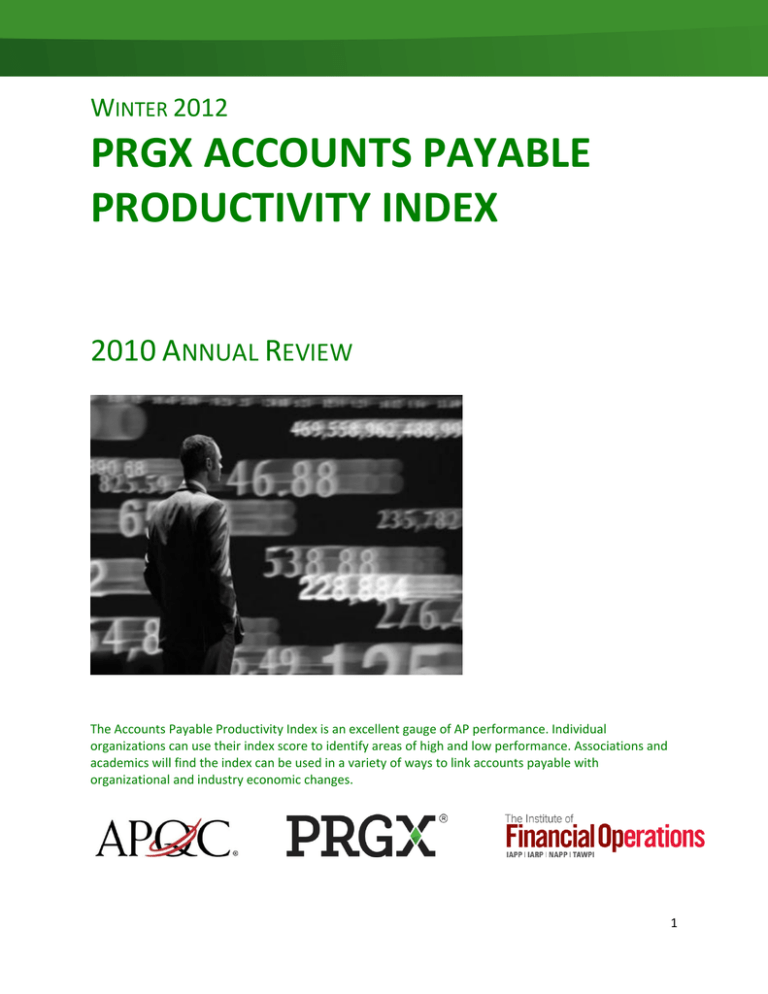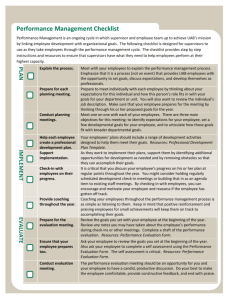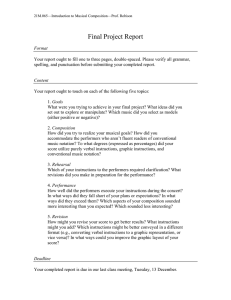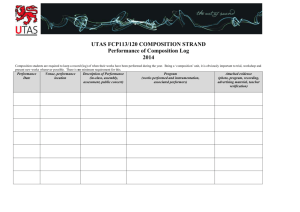
WINTER 2012
PRGX ACCOUNTS PAYABLE
PRODUCTIVITY INDEX
2010 ANNUAL REVIEW
The Accounts Payable Productivity Index is an excellent gauge of AP performance. Individual
organizations can use their index score to identify areas of high and low performance. Associations and
academics will find the index can be used in a variety of ways to link accounts payable with
organizational and industry economic changes.
1
Published January 2012. Copyright © 2012 by The Institute of
Financial Operations in conjunction with its affiliates: International
Accounts Payable Professionals (IAPP), International Accounts
Receivable Professionals (IARP), National Association of Purchasing &
Payables (NAPP), and The Association for Work Process Improvement
(TAWPI) and PRGX Global, Inc. (PRGX)
All rights reserved. Reproduction or transmission of this publication in
any form without the express permission of the copyright holder is
prohibited and is a violation of federal copyright law.
The information contained herein has been diligently obtained from
sources believed to be reliable and has been prepared with care. The
Institute, IAPP, IARP, NAPP, TAWPI, and the authors disclaim any and
all warranties as to the accuracy and completeness of this
information. The Institute, IAPP, IARP, NAPP, TAWPI, and the authors,
their directors, employees, or assistants can accept no liability for any
damages or loss occasioned to any person, company, or entity due to
errors or omissions in the information contained herein or in the
interpretation thereof. The opinions expressed herein were developed
from a global survey of users and the analyses may contain the
opinions of the author and may change at any time without notice.
This publication is designed to provide authoritative information at
the time of publication in regard to the subject matter covered. It is
not intended to offer accounting, legal, or other professional advice.
If accounting, legal, or other professional advice is required, or if
expert assistance is needed, the services of a competent professional
person should be sought.
This document or any part thereof may not be reproduced in any form
without the express written permission of the publisher.
Background
The PRGX Accounts Payable Productivity Index (APPI) was developed using eight core AP
performance indicators that measure efficiency and effectiveness of the accounts payable
process, as well as two optional measures of cycle time1 (see Table A). All indicators are
recognized standards for assessing AP performance and have been vetted by subject matter
experts in the finance industry. Initial development of the APPI utilized data from a diverse set
of organizations (based on industry, geographic location, and revenue size) that had
participated in APQC’s AP benchmarking efforts over the last six years. With support from PRGX
and IAPP, APQC continues to collect and update the APPI regularly with data from new
participating organizations.
Table A: PRGX AP Productivity Index Composition
Individual organizations that provide data receive a customized report showing their overall
APPI score and a detailed comparison for each metric that comprises the index, highlighting
their performance relative to the entire data set. The APPI is an excellent guide post and tool
for organizational leadership to assess current AP performance, identify specific AP-related
areas of improvement opportunity, and measure or monitor performance improvement
against.
The APPI provides valuable insight into AP performance trends that can be used by suppliers,
consultants, associations, and researchers to gauge the overall efficiency and effectiveness of
AP processes and disciplines, as well as the impact of process and organizational changes and
enabling technology deployment on AP performance.
Top Performance Breakpoints - Users of the index can identify where performance gaps exist
between current performance levels and top performers. Suppliers and consultants can use
1
For more information about the methodology use to create the index, download a copy of the initial project report
3
the APPI to assist clients identify and define which improvement opportunities will have the
greatest impact on performance.
Top Performance Practices – Biannually APQC and PRGX analyze the APPI and identify the
common AP “leading practices” that are employed by Top Performing organizations. These
leading practices provide insight into what drives top performance across the entire data set
and within demographic data cuts by company size and primary operating geography.
This report provides a summary of the APPI for the 2010 calendar year. It is important to note
that the index typically has a six- to twelve- month lag simply due to the fact that organizations
must wait until the end of their fiscal year to provide an annual summary of their data.
Executive Summary
The PRGX Accounts Payable Productivity Index (APPI) showed a strong improvement in both
effectiveness and efficiency scores in 2010 over 2009 for both Median and Top Performance
levels across virtually all demographic segments of the database, indicating companies are
continuing to invest in improving AP performance and are reaping the benefits of these
investments. Top performing organizations (top quartile scores in both efficiency and
effectiveness) continue to be found in all geographic regions and all sizes of organizations.
During 2010 Top Performing organizations continued to push the AP performance bar higher as
the APPI index for Top Performers rose by 5.5% to an APPI of 65.4, up from 62.0 in 2009.
Comparison of the Top Performance efficiency and effectiveness scores reveal average
effectiveness score rose by nearly 8% and efficiency scores reduced by 3% indicating a shift in
focus on improving customer service, cycle times and payment accuracy within defined terms.
2010 also saw Median Performers increase their overall performance by 2.5% to an APPI of
51.0, up from 48.8 in 2009. Median Performance experienced an 11% increase in efficiency
scores and a near 4% increase in effectiveness indicating a continued focus to reduce operating
cost without sacrificing process and service effectiveness.
However, Bottom Performers continue to struggle with a lack of focus and executive support to
improve AP performance, and the gap between medium and bottom performers continued to
widen in 2010, as Bottom Performance decreased 20% down to an APPI of 28.5 compared to
35.5 in 2009.
These results indicate that many more organizations are actively seeking out and investing in
ways to improve both the efficiency performance (operating cost and productivity) of as well as
the effectiveness (service cycle times and payment accuracy) of their AP processes and
organizations.
Comparison of Top Performance
Top Performers’ scores - when compared to Median Performance – shows that Top Performers
significantly outperform Median Performers in terms of efficiency with AP cost to process an
invoice 46% lower, AP cost per $1,000 in revenue is 24% less, and AP productivity (invoices per
AP FTE) 60% higher than Median Performers.
On the effectiveness side of the equation, the gap between Top Performers’ and Median
Performance is not quite as drastic, with Top Performers holding an 8% advantage in the
percent of invoice line items paid on time, an 11% edge in percentage of discounts available
that are taken and a 33% advantage in cycle time in days to resolve an invoice error.
Today, virtually every organization has invested in core accounts payable application
functionality to manage the basic processing and payment of supplier invoices and other third
party (non-employee) payments. While it is true Top Performing organizations are more likely
to have a single enterprise AP application they leverage across the enterprise solution (albeit
many large organizations may operate multiple instances of this solution) rather than multiple
solutions. This is no longer a prominent factor in distinguishing performance.
5
There are several prominent practices and activities that we see today among top performing
organizations (75th quartile of the APPI) which substantially impact performance:
Elimination of paper invoice receipt from suppliers and transitioning to higher levels of
invoice automation. Whether from expanding traditional forms of electronic data
interchange, “EDI” utilization and/or newer forms of electronic invoice presentment for
payment, “EIPP”. Especially with strategic and high transaction volume suppliers.
Average top performers receive 30-45% of total invoices electronically from suppliers.
High usage of automated/evaluated receipt settlement (especially in manufacturing and
product and goods intensive accounts payable environments). Average Top Performers
still use ERS/ARS for more than 10% of invoice volume.
High utilization of advanced data capture, document scanning, and optical character
recognition, “OCR”, for initial digitization and conversion of paper invoices into
electronic data.
High utilization of shared services operating model for accounts payable processing.
The majority of Top Performers deploy shared services centers (either captive or
outsourced) to receive and digitize paper invoices, manage invoice processing
exceptions, and manage payment processing activities. Many Top Performers gain
additional cost structure advantages by locating AP shared services operations in lower
cost operating geographies.
High utilization of rules based automated workflow solutions to effectively manage the
flow of electronic invoice data and images through the organization for required
approval and authorization for payment.
Effective deployment of purchasing card programs, “P-cards” to empower employees to
efficiently make low value, non-recurring purchases from infrequently utilized suppliers.
Average Top Performers utilize P-cards to displace 6-8% of invoice volume.
Effective deployment of electronic based catalogues for web based purchasing and
electronic settlement (P-cards or ERS) with strategic suppliers for contract priced
recurring and high volume transactional activity.
Through a combination of the aforementioned practices, we have noted a decline in the
traditional utilization of two-way (invoice and PO) and three-way (invoice, PO and receiving
document) matching by Top Performers. Today we see very few organizations attempting to
continue to perpetuate the failed “no purchase order no pay” policies we saw in the early
2000’s. We see the preponderance of Top Performers successfully providing a controlled
environment of limited options to purchase goods/services and settle with suppliers when
there is no PO. Educating end users on how best to utilize these options is dependent on the
value and frequency of the purchase activity and the supplier they are utilizing.
In analyzing top performance we have identified some general performance patterns:
There is a definite advantage to size and scale. While we do find Top Performers across
all the geographies and sizes of organizations, the predominant demographic profile for
Top Performers is larger organizations with considerable invoice volume and scale.
Organizations with higher revenues tend to have higher APPI scores.
Organizations with a predominant portion of operations in the US score higher in the
APPI
7
Participant Demographics
As of November 1, 2011 the APPI comprises data from 375 organizations2, up from 333
reported in the Spring 2011 update. Organization participation in 2010 returned to more
normal levels after a 30% spike in participation in 2009 (See Figure 2).
Figure2: Number or Respondent Organizations by Year
While additional 2010 data may still be received from some organizations, we anticipate the
impact on 2010 performance metrics and trends comprised in this report will be minimal.
Organizations from the U.S. and EMEA
continue to be the most prevalent
demographic segment of APPI survey
participants. Fifty-seven percent of
participating organizations are located in
the United States and twenty-one
percent within EMEA, with the majority
of these located in the UK and
Continental Europe (Figure 3).
This is not surprising given the intense
focus of organizations within these
regions to improve operating efficiencies and effectiveness in back office functions. Challenging
U.S. and European market and economic pressures coupled with advancing capabilities in
automation best practices such as electronic invoice presentment for payment (EIPP), advanced
data capture, and enterprise content and workflow management, and expanded working
capital optimization practices and services such as supply chain financing and dynamic
discounting, are continuing to drive organizations to seek to attain additional efficiency and
effectiveness in their accounts payable processes.
Organizations across all industries and sizes continue to participate in the study with fifty-one
percent of participants with annual revenues of $1 billion or greater, and forty-nine percent
with annual revenues of less than $1 billion (Figure 4), providing a strong indication that
accounts payable performance continues to be of keen interest to many organizations.
While the APPI is comprised of
organizations from various revenue sizes
and operating geographies from around
the globe, it should be noted that fortyfive percent of the total organizations
represented the APPI are comprised of
three groups or organizations. These are:
$1 Billion to $5 Billion in the US – 18%
Less than $500 Million in the US – 15%
Less than $500 Million in EMEA – 11%
The APPI is also comprised of organizations across various industries with Industrial Products,
Pharmaceuticals, Retail & Wholesale, Consumer Products and Packaged Goods, and Electronics
being the largest groups of industry participants in the study. Figure 5 provides a breakdown of
the APPI participants by industry group.
Overall PRGX APPI Productivity Index
During 2010 the median APPI rose by 2.5% from 48.8 to 51.0 driven primarily by an 11%
increase in efficiency and a more modest increase in effectiveness of 4%. Changes in the
efficiency metrics of the index drove performance up 5.1 points, from 46.0 in 2009 to 51.1 in
2010 (Figure 6). The increase in efficiency was the result of a 50% improvement in “total cost
to process accounts payable per $1,000 in revenue” (from $1.02 in 2009 to $0.51 in 2010),
9
indicating participating organizations are continuing to gain greater leverage from their
accounts payable departments through continued leverage of globalization, shared services,
and EIPP and invoice advanced data capture technologies. In addition the level of
disbursement automation continued to increase as the “number of disbursements per accounts
payable FTE” rose in 2010 by 30% to 3,829 up from 2,939 in 2009, indicating more organizations
and their suppliers are continuing to embrace and expand electronic payment practices.
While the median trend in efficiency has continued upward since 2008, the 2010 increase is less
than half of the efficiency increase experienced in 2009, and Top Quartile Performer efficiency
metrics actually fell by 3.0 points from 68.2 in 2009 to 65.2 in 2010 (Figure 7), indicating that as
organizations move further up the accounts payable transformation maturity curve efficiency
gains are becoming more difficult to realize.
Changes in the effectiveness metrics of the index drove performance up 3.1 points, from 47.8 in
2009 to 50.9 in 2010 (Figure 6). This increase in effectiveness was pervasive in the data, with
five of the six effectiveness metrics improving in 2009 with the only exception being “cycle time
from receipt of invoice until approved and scheduled for payment” which remained constant
at 5 days in 2010. The increase in effectiveness was primarily the result of a 45% improvement
in “number of FTEs performing the accounts payable process per $1 billion revenue” (from 12.4
in 2009 to 6.8 in 2010), indicating organizations are continuing to perform payables activities
with lower staffing levels through a combination of increased business process outsourcing and
productivity gains through expanded automation. In addition “cycle time in days to resolve an
invoice error” improved by 53 % to 3 days in 2010 compared to 7 days in 2009, and the
“percentage of discounts available that are taken” improved by 12% to 89.3% in 2010
compared to 80% in 2009, indicating the increases in invoice visibility and process exceptions
organizations are gaining through expanded utilization of invoice advance data capture and
digitization techniques and rules based automated workflow management technologies.
As the median trend in effectiveness has continued upward since 2008, the 2010 increase is
slightly more than half the efficiency increase experienced in 2009 (11% in 2009 and 6.5% in
2010), indicating that Median Performers continue to be more highly focused on efficiency
gains rather than effectiveness as they continue to strive to reduce cost and improve
productivity in the accounts payable process and close the gap to top performance. Conversely
Top Performers effectiveness metrics increased by 4.7 points to 64.8 in 2010 up from 60.1 in
2009 (Figure 7), an increase of nearly 8%, indicating Top Performers are becoming more
focused on effectiveness as opportunities for efficiency enhancement become more difficult as
organizations reach advanced levels of accounts payable transformation maturity.
The APPI performance gap between Median and Top Performers remained nearly the same in
2010 with Top Performers scoring 28% higher in 2010 as compared to 27% higher in 2009.
Median narrowed the performance gap in efficiency during 2009 as enabling technologies
became more affordable and accessible via software as service platforms and business process
outsourcing options expanded, while Top Performers widened the gap in effectiveness.
So the race for optimal accounts payable performance continues with no clear finish line in site,
as organizations across all industries, regions and revenue size continue to pursue accounts
payable performance improvement.
11
Best Practices of Top Performers
All organizations desire to understand the profile of Top Performers and the practices being
deployed by these organizations which drive superior performance. To gain insight into the key
drivers of Top Performers we analyzed the performance of 83 top performing organizations
from 2010 (based on top quartile performance of the APPI).
Table B shows the breakpoints for each of the ten metrics that comprise the PRGX AP
Productivity Index, for both Top Performance (defined as top quartile) and the overall Median
performance for all organizations in the index.
Based upon a standard set of statistical tests and analysis the following practices utilized by top
performers have a significant impact on their performance metrics, setting them apart from the
practices of their Median performing counterparts.
An overwhelming majority, in excess of 85% of top performers utilize a standard ERP
application to coordinate accounts payable and purchasing processes, activities,
information and resources. Oracle is the most prominent application utilized (34% of
Top Performers) followed closely by SAP (25% of Top Performers).
The majority of Top Performers utilize a specific travel and expense reimbursement
application to process travel expense reimbursement requests outside of the
accounts payable application. Concur is the prominent application utilized by 38% of
Top Performers. It is interesting to also note the majority of Top Performers
continue to utilize the accounts payable application to generate expense
reimbursements to employees, with less than 25% of Top Performers leveraging
payroll applications to generate employee reimbursements. It is also interesting to
note that the majority of Top Performers have a high degree of expense
reimbursement settlement made through electronic methods (with in excess of 90%
of settlements made via direct deposit).
The majority of Top Performers, in excess of 95%, leverage automated matching
functionality and exception based management rules and functionality located in their
ERP applications to automate PO supported invoice processing and manage PO invoice
processing exceptions. Those that do not leverage this functionality in their ERP
application deploy a similar functionality in their work flow management application of
choice.
The majority of Top Performers, in excess of 90%, report utilizing standard processes
and policies across the enterprise to manage accounts payable processes and activities.
An overwhelming majority of Top Performers, in excess of 80%, utilize shared services
operating model for accounts payable processing. The majority of top performers
deploy shared services centers (either captive or outsourced) to receive and digitize
paper invoices, manage invoice processing exceptions, and manage payment processing
activities. The majority of Top Performers, in excess of 60%, take advantage of
favorable labor and operating cost structure globally by locating AP shared services
operations in lower cost operating geographies in Latin America, Asia, and Western
Europe.
The majority of Top Performers, in excess of 75%, deploy advanced data capture,
document scanning, and optical character recognition, “OCR”, for initial digitization and
conversion of paper invoices into electronic data (by either investing in these
technologies or leveraging selective outsourcing for these services)
The majority of Top Performers, in excess of 85%, effectively deploy a rules based
automated workflow solutions to effectively manage the flow of electronic invoice data
and images through the organization for required approval and authorization for
payment.
Near 70% of Top Performers effectively deploy purchasing card programs, “P-cards” to
efficiently make low value, non recurring purchases. Median top performers utilize Pcards to displace 6-8% of invoice volume.
Over 60% of Top Performers have effective programs to actively promote and expand
e-invoicing receipt from suppliers. Median Top Performers receive 30-40% of supplier
invoices electronically (best performers can achieve near 70% electronic invoice
receipt).
Over 55% of Top Performers deploy some form of supplier and internal customer self
service tool to provide insight and information into status of invoice processing and
payment activity
13
Over 40% of Top Performers utilize electronic based catalogues for web based
purchasing and electronic settlement and have active programs to expand electronic
catalogue utilization.
Fewer than 20% of Top Performers are actively deploying supply-chain financing
alternatives and tools
It is clear from our analysis of Top Performers, that there is no one silver bullet or best practice
that drives Top Performance, but rather five key attributes that observed that are present in all
Top Performers:
1. A shared insatiable drive to optimize procure-to-pay performance by both accounts
payable and purchasing leaders and personnel.
2. Committed and active Executive support to challenge the organization to seek out and
accept change to improve business performance.
3. The collective deployment of a number of process, organizational and technology best
practices, successfully designed and crafted into a well-controlled environment of
limited options to purchase from and settle with suppliers.
4. Effective education of end users on how best to utilize these options depends on the
value and frequency of the purchase activity and the supplier they are utilizing.
5. Ongoing monitoring of performance improvement across a balanced set of efficiency
and effectiveness measures and targets.
The PRGX APPI by Region
The United States remains the highest performing region in the APPI study, with organizations
based in the US significantly outperforming other geographical regions. Median APPI scores for
the US, at 55.2 are nearly 9 points higher than the next closest region, Asia-Pac (Figure 8).
Median performance across Regions remained substantially unchanged with the addition of
2010 data. US Top Performance APPI score of 65.2 indicates many organizations in the US
have achieved an exceptionally high performing accounts payable process when compared to
other regions.
One factor consistent across all regions prior to 2010 was a year to year improvement in the
productivity levels based on the number of invoices and disbursements processed. However in
2010 the “total cost of processing accounts payable per invoice rose for both Median and Top
Performers by 12%-13%, and the “number of AP invoices processed per accounts payable FTE”
fell for Median and Top Performers by 5%-6%.
The strongest correlation between best practices and performance across regions can be found
in the four cost and productivity metrics which are prominent components of calculating the
APPI, efficiency, and effectiveness metrics. Within Top Performers, US organizations
consistently outperform organizations from other regions in cost per invoice and cost of the AP
process per $1,000 in revenue (Figures 8 and 9).
15
The superior performance in operating cost metrics by US Top Performers is driven by a
number of contributing factors. Most notable are the extremely high degree of process
standardization and process automation deployed, extensive leverage of global shared services
operations in low cost geographies, a less complex payables regulatory and compliance
environment, and less complex internal operating and supplier multi-lingual support
requirements.
We also see the impact of favorable labor rates and operating cost structures in Asia-Pacific Top
Performers. However, the labor arbitrage benefits from operating AP shared services
operations in this region are somewhat offset by the additional regulatory compliance, multilingual support requirements, and the lower degree of invoice automation by the general
supplier community in this region. At median performance levels we begin to see the clear
impact of favorable labor and cost structures in Asia-Pacific organizations as the degree of
process automation, lower-value work elimination and productivity levels decline in Median
performers, and this is even more dramatic in 25th Performers (the bottom quartile of
performance). It is evident that organizations in the bottom fifty percentile of performance
across all regions have the most benefits to be gained through globalization, and as the degree
of automation and productivity expand to Top Performer levels the value of labor arbitrage
gained through globalization substantially diminishes.
Within Top Performers US organizations also outperform other regions in key productivity
metrics, such as number of invoices processed annually per AP FTE and number of
disbursements processed annually per AP FTE (Figures 10 and 11).
US Top Performers outperform organizations in other regions by 25%-45% in invoice processing
productivity, and this performance trend is consistent across Median and 25th performers as
well. US organizations superior productivity performance is driven by high degrees of advanced
data capture work flow management automation, electronic invoice presentment for payment
utilization, and supplier and employee self service adoption. US Top Performers only hold a
slight performance advantage over the Rest of the Americas and EMEA , where electronic
payment practices are well developed and generally accepted by the supplier community. The
performance difference at Median and 25th performers across regions in payment automation
is more internally driven based on an organizations desire to engage their supplier community
in electronic payment enrollment programs.
PRGX APPI by Revenue Size
Top Performers exist across organizations of all revenue sizes and volumes of supplier invoices
managed, therefore, clearly size and scale are not a prerequisite to achieving top performance.
However, large organizations with substantial supplier invoice volumes and operating
complexities have a much greater opportunity to generate added business value by more
effectively and efficiently managing the accounts payable process. Size and scale can be both
an asset and liability in optimizing AP performance. While size brings opportunities it also brings
additional complexity and greater risk of disjointed strategies, work fragmentation and
uncommon processes.
Large organizations have greater opportunities to leverage economies of scale and best practice
investments in the AP service delivery model (shared services) and AP automation tools (invoice
advanced data capture, EIPP, workflow management, and self service). However, with the
expansion of cloud computing, software as service models, and business process outsourcing,
the opportunity to leverage enabling technologies and globalization, the opportunity for mid
size and smaller organizations to leverage best practices is far greater in 2010 than ever before.
The APPI metrics indicate higher levels of performance in cost of service and productivity
metrics can be achieved by larger organizations where AP best practices are effectively
17
deployed and perpetuated (Table C). However, size is not a determining factor in achieving Top
Performance, as there are many large organizations in the Median and 25th percentile
performance groups.
Top Performers in larger organizations are able to effectively leverage the benefit of volume
and scale along with best practices utilization to realize higher levels of productivity and cost
performance, providing them a distinct advantage in efficiency over smaller sized organizations.
Organizations “less than $500 million” in revenue size category average about 12% of invoices
received and 17% processed electronically. The average percentage for these two metrics
increases by 5-10% for each larger revenue peer group. Larger organizations are also more
likely to leverage advanced invoice data capture/digitization and automated invoice workflow
management tools than smaller organizations. The usage of these tools is found in nearly 100%
of participating organizations “over $10 billion” in revenue as compared to only 30-40% of
organizations less than $1 billion in revenue. The lower level of invoice automation and
technology deployment in organizations with less than $1 billion in revenue has a substantial
impact on the cost and productivity performance of these participants.
Organizations over $5 billion in revenue have a greater propensity to leverage globalization
strategies to reduce accounts payable operating cost structures, with greater than 65% of these
organizations deploying some form of global shared services and/or BPO strategy in the
delivery of AP processing services as compared to less than 35% of organizations with less
than$5 billion in revenue.
There is little correlation between organization size and effectiveness performance, with the
exception of the “number of FTEs performing accounts payable process per $1,000 in revenue,
which follows the pattern of larger organizations benefiting from size and scale. Effectiveness
performance in organizations appears to be driven primarily by the organizations desire and
ability to establish and monitor service delivery and days payable outstanding (working capital
management) performance than any other driver.
Conclusion
During 2010 the Median APPI rose by 2.5% from 48.8 to 51.0 and Top Performer APPI rose by
5.5% from 62.0 to 65.4, indicating the gap between Top Performers and Median continues to
widen.
Operating cost and productivity performance is still king with Median Performers. The 2010
Median APPI performance was driven by a healthy 11% increase in efficiency and a more
modest 4% increase in effectiveness, indicating Median Performers are heavily focused on
generating business value through operating cost reductions and productivity improvements.
Median Performers are closing the efficiency gap between themselves and Top Performers
with the APPI efficiency gap narrowing from 22.2 in 2009 to 14 .1 in 2010 (Figure 12).
While operating cost and productivity performance remained high for Top Performers in 2010
the focus on improving effectiveness is on the rise. Top Performers increased effectiveness by
19
8% to 64.8 up from 60.1 in 2009. Top Performers continued to maintain high levels of
efficiency in 2010. However, Top Performer efficiency dropped for the first time ever in 2010,
falling to 65.2 compared to 68.2 in 2009, a 4% decline (Figure 12). This efficiency decline
resulted from an increases in “accounts payable processing cost per invoice”, while invoice
processing productivity levels remained virtually unchanged. This performance indicates the
increase of accounts payable operating cost without increased staffing levels. This change in
performance might be driven by the convergence of a number of contributing factors including
increased outsourcing fees, depreciation from new capital investments, and a change in staff
mix where more expensive resources are being deployed to manage more complex invoice
exception resolution and service delivery issues.
Have Top Performers finally reached their optimal accounts payable efficiency levels? Or can
they generate more productivity and cost savings from the process? Will the efficiency gap
between Median and Top performers finally begin to close? Will the upward trend in
effectiveness performance continue? We will continue to research APPI performance to seek
answers to these questions as 2011 performance data is received and analyzed.
For those of you new to the AP Productivity Index, one of your most valuable assets is the
ability for your organization to assess current performance against the index. Doing so can
provide you a starting point to uncover and identify your organizations improvement
opportunities and begin to answer the questions of:
How well is your AP process and organization performing against your peers?
Are you making the same performance improvement gains as others or are you falling
further behind in performance?
Participation in and/or utilization of the index can provide you an objective fact based basis to
understand your organization’s performance improvement opportunities and assist you in
shaping your improvement strategy. The index is a tool to assist you in assessing the efficiency
and effectiveness performance of the accounts payable process; in order to identify areas of
success and needed improvement; and quantify your potential return on investment of closing
if the performance gaps are closed.
About APQC
Since 1977, APQC has been focused on providing organizations around the world with the information
they need to work smarter, faster, and with confidence. Every day we uncover the processes and
practices that push organizations from good to great. As one of the world’s leading proponents of
process and performance improvement, we follow our mission to help organizations around the world
improve productivity and quality by:
discovering effective methods of improvement,
broadly disseminating findings, and
connecting individuals with one another and with the knowledge they need to improve.
123 North Post Oak Lane, Third Floor
Houston, TX 77024-7797
phone: +1-713-681-4020 or 800-776-9676
fax: +1-713-681-8578
e-mail: apqcinfo@apqc.org
www.apqc.org
About PRGX Global, Inc.
Headquartered in Atlanta, Georgia, PRGX Global, Inc. is the world's leading provider of recovery
audit services. With approximately 1,500 employees, the company operates and serves clients
in more than 30 countries and provides its services to over 75% of the top 30 global retailers.
PRGX is also pioneering Profit Discovery, a unique combination of audit, analytics and advisory
services that improves client financial performance. For additional information, please visit
PRGX at www.prgx.com.
About IFO
The Institute of Financial Operations is the umbrella association comprising four membership
affiliates for finance professionals:
International Accounts Payable Professionals (IAPP), International Accounts Receivable
Professionals (IARP), the National Association of Purchasing and Payables (NAPP), and The
Association for Work Process Improvement (TAWPI). Based in Orlando, Fla., with offices in
Boston, New York, and London, the Institute serves as a global voice, chief advocate, recognized
authority, acknowledged leader, and principal educator for people in financial operations, with
a particular focus on accounts payable, accounts receivable, automation, data capture, and
procure-‐to-‐pay. Combined, the affiliates have more than 6,000 members.
21





